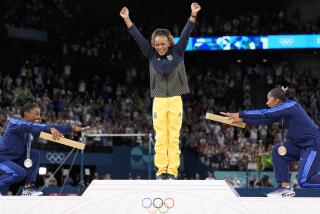Nationalism Comes at a Price
- Share via
SANTO DOMINGO, Dominican Republic — It has been more than 500 years since Christopher Columbus landed on these shores. Yet residents of Santo Domingo still celebrate with pride their city’s distinction as the oldest in the New World.
So although there was widespread opposition to bringing the XIV Pan Am Games to Santo Domingo because of the financial strain on the city and the country, pride took over once local residents accepted the fact athletes and spectators from throughout the Western Hemisphere would be visiting for the Games, which conclude with today’s closing ceremony.
Rather than yank away the welcome mat, this city exceeded even the most optimistic expectations in playing host to an event it once seemed ill-equipped to stage.
“We had no business taking on something like this that will cost more than $150 million,” said one local Pan Am official, who did not want to be named. “This is using money we need for schools, for roads, for medicine for our hospitals. But once it was done, what are we going to do? We have worked hard to make it a success.”
While there are no certifiable polls gauging public support of the Games, the boos that accompanied appearances by Dominican President Hipolito Mejia illustrate some public displeasure with the cost incurred. So did disturbances in the streets on the night of the opening ceremony.
Yet grumbling or no grumbling, a massive national effort produced, in a matter of months in some cases, the venues and other structures needed to host more than 7,000 athletes from 42 nations competing in 38 sports.
Even as the torch was ignited to open the Games, bulldozers were still moving earth and new roads were still being paved.
Perhaps reflecting unhappiness over the presence of the Games, many events were poorly attended, some embarrassingly so. It was hard to get accurate numbers of paying customers because at some venues, when it was obvious the seats weren’t going to be filled, officials opened the gates and let spectators in free.
But those crowds seemed to gather only when local athletes were involved.
At the basketball arena, there were such sparse crowds for some games, you could hear the sneakers of the players squeaking on the court.
But when the Dominicans played, the fans filled the arena, sat three across in the aisles and even perched on the wall rimming the upper deck.
When that wall was filled, additional fans were told they could come in only if they agreed to keep walking around that upper deck without stopping.
An estimated 13,000 were crammed into an arena that seats 10,000 for the men’s basketball final between the Dominican Republic and Brazil.
The Pam Am torch blazed in Juan Pablo Duarte Olympic Stadium and the athletes were housed in the Olympic village. Dominican officials know this is as close as they will ever get to staging an Olympics, but, after 17 days of competition, they can boast of an event that went relatively smoothly.
There were the usual glitches, but nothing serious.
There was a miscommunication on a medal ceremony. Two Brazilians and a Canadian were the medal winners in the men’s 800-meter run. Only one Brazilian joined the Canadian on the victory platform. The second Brazilian, silver-medal winner Osmar dos Santos, somehow didn’t get the word. A Brazilian official asked a Canadian official if the ceremony could be rescheduled for the next day. Only, the Canadian official said, if the Brazilians wanted to pay for a return flight. The Canadian had already gone home.
There was some dissatisfaction with the playing of the national anthems. In an effort to cut down on the time spent, with several anthems running six to seven minutes, it was decided to use only a portion of each anthem. That left some athletes complaining about disrespect.
After the Colombia-Cuba soccer match, the Brazilian anthem was played instead of the one for Colombia. At least it’s assumed it was supposed to be for Colombia since Cuba got nothing at all when its anthem couldn’t be located. So nobody was happy.
But from the U.S. athletes, who have been known to express displeasure in the past if conditions weren’t up to their standards, there was hardly a peep.
There were the isolated ugly incidents of the type found at any event of this size. Miami Herald sportswriter Kevin Baxter was dragged a few yards when he refused to let go of his computer bag as would-be thieves on a motorcycle grabbed the strap. Baxter wound up with a cuts and bruises, but the computer wasn’t damaged. Joe Douglas, manager of the Santa Monica Track Club, had his cell phone stolen off his belt as he walked down a street.
Pan Am pins became the coin of the realm, valued by locals even more than pesos. Getting game credentials upon arrival could take hours, but slipping a local official a pin could magically clear the way in minutes.
Perhaps the moment that best sums up these games occurred when U.S. press officer Ryan John tried to put his bag through a venue X-ray machine. When the bag proved too big, a security official pulled out an electronic wand, ran it around the bag and motioned that John was free to proceed.
Well and good, except the official had neglected to turn the wand on.
So it was with the XIV Pan Am Games. Things didn’t always go as planned for the Dominicans. But nobody can say they didn’t try.
More to Read
Go beyond the scoreboard
Get the latest on L.A.'s teams in the daily Sports Report newsletter.
You may occasionally receive promotional content from the Los Angeles Times.










